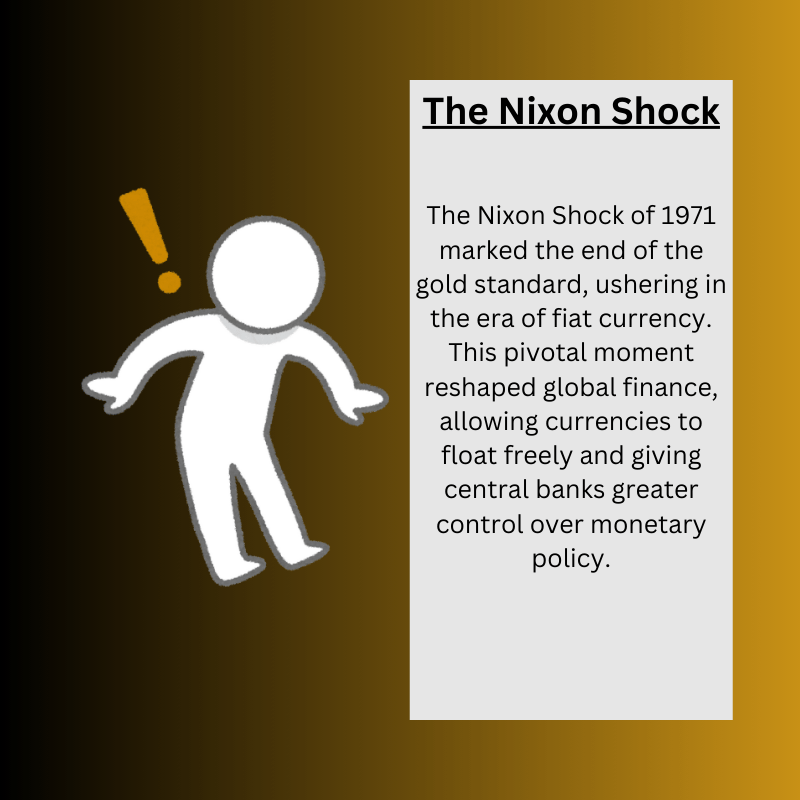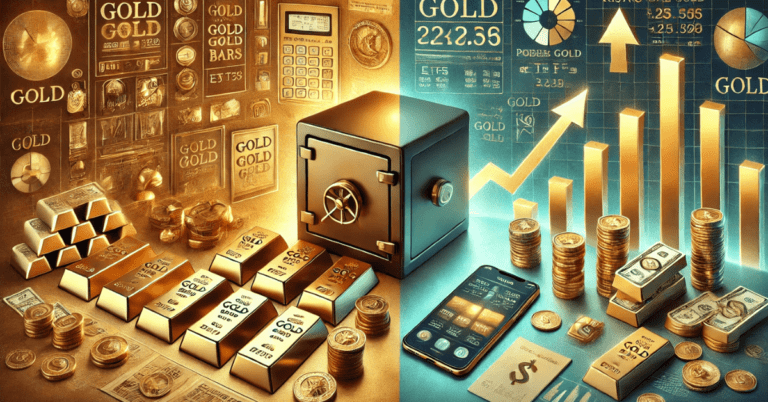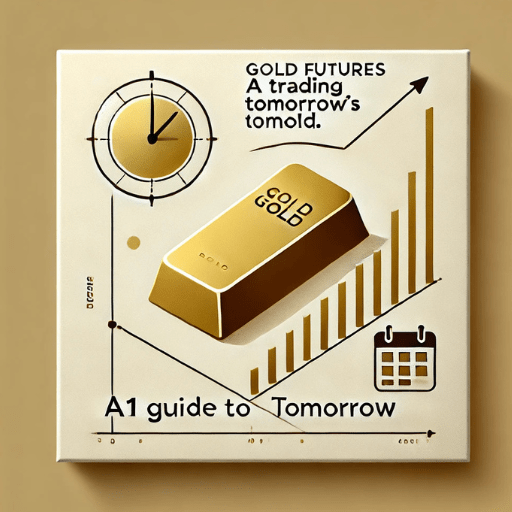Ever wonder why your grandparents could buy a house with what feels like pocket change today? Or why saving money feels like a race against inflation you just can’t win? The answer lies in one of the most significant economic transitions in modern history: the shift from the gold standard to fiat currency. Let’s explore this fascinating journey that transformed the very nature of money as we know it.
Key Takeaways: Gold Standard to Fiat Currency
The transition from gold standard to fiat currency represents one of the most significant economic changes in modern history. While it has provided governments with more tools to manage their economies, it has also introduced new challenges for ordinary citizens trying to preserve their wealth.
Understanding this history helps us:
- Make better financial decisions
- Appreciate the nature of money
- Plan for long-term financial security
- Navigate the modern economic landscape
The Origins of the Gold Standard: A Foundation of Trust

The story of modern money begins in England. In 1717, Sir Isaac Newton, as master of the Royal Mint, established a new monetary system that would change the world. England became the first country to officially implement the gold standard, setting a precedent that other nations would follow for centuries to come.
Imagine this: every dollar in your pocket was backed by actual gold. The concept was beautifully simple – governments could only print money if they had the gold to back it up. This created a natural limit on currency circulation and provided a foundation of trust that would last for generations.
The gold standard offered several key advantages:
- Price stability across international borders
- Natural constraints on government spending
- Predictable exchange rates between currencies
- A universal measure of value
The Bretton Woods Era: Redefining Global Finance
As we moved into the 20th century, a pivotal moment arrived in 1944. In the quiet New Hampshire town of Bretton Woods, delegates from 44 allied nations gathered to create a new international monetary system. The Bretton Woods Agreement established a modified gold standard that would govern international finance for the next quarter-century.
Under this system, the U.S. dollar became the world’s reserve currency, backed by gold at $35 per ounce. Other currencies were pegged to the dollar, creating a stable network of exchange rates. This arrangement reflected America’s dominant economic position after World War II and established a framework for international trade and finance.
The system worked remarkably well for a time, contributing to:
- Post-war economic recovery
- Expansion of international trade
- Stable currency relationships
- Growing prosperity in developed nations
The Path to Change: Strains in the System
However, by the 1960s, cracks began to appear in the Bretton Woods system. The costs of the Vietnam War and ambitious domestic programs like the “Great Society” put enormous pressure on U.S. finances. Foreign governments, particularly France, began to question the dollar’s gold backing and demanded conversion of their dollar holdings into gold.
As U.S. gold reserves dwindled, it became clear that something had to give. The system that had provided stability for decades was becoming unsustainable.
The Nixon Shock: A Monetary Revolution

On August 15, 1971, President Richard Nixon delivered a television address that would change the global financial system forever. In what became known as the “Nixon Shock,” he announced that the United States would end dollar convertibility to gold, effectively abandoning the gold standard.
This dramatic decision was driven by several factors:
- Declining U.S. gold reserves
- Growing trade deficits
- Rising inflation pressures
- The need for monetary flexibility
The immediate impact was significant. The dollar’s value floated freely for the first time, and the era of fiat currency had begun.
The Transition Years: Adapting to a New Reality
The period between 1971 and 1976 marked a crucial transition in monetary history. Countries around the world had to adapt to a new system where currency values were determined by market forces rather than gold. In 1976, the International Monetary Fund (IMF) officially redefined the dollar with no connection to gold, marking the end of an era.
This transition brought both opportunities and challenges:
- Greater monetary policy flexibility
- Increased economic uncertainty
- New tools for managing national economies
- The rise of currency trading markets
Modern Fiat Currency: Understanding the System
Today’s fiat currency system operates on a fundamentally different principle than the gold standard. Instead of being backed by precious metals, modern money derives its value from government decree and public trust. This system gives central banks unprecedented control over monetary policy but also creates new risks and challenges.
Key Features of the Modern System:
Central Bank Authority
Central banks can now:
- Control money supply
- Influence interest rates
- Respond to economic crises
- Manage inflation targets
Economic Implications
The fiat system has led to:
- More frequent economic cycles
- Higher average inflation rates
- Greater currency volatility
- Increased financial innovation
The Impact on Modern Life:Gold Standard to Fiat Currency
The transition to fiat currency has profoundly affected everyday life in ways many people don’t realize:
Housing and Assets
Property values have risen dramatically, not necessarily because houses are worth more, but because the purchasing power of currency has declined. Your grandparents’ seemingly cheap house purchase reflects this fundamental change in our monetary system.
Savings and Investment
Traditional savings accounts no longer preserve wealth effectively due to inflation. This has pushed more people into the stock market and other investments, fundamentally changing how we plan for the future.
Economic Stability
While the fiat system offers more tools for managing economic crises, it has also led to more frequent boom-and-bust cycles, affecting job security and business planning.
Looking to the Future: Modern Alternatives
The challenges of fiat currency have sparked interest in alternatives:
Cryptocurrencies
Digital currencies like Bitcoin have emerged as potential alternatives, offering some gold-standard-like features in a digital form:
- Limited supply
- Independence from government control
- Potential hedge against inflation
Modern Gold Investment
While we’re unlikely to return to a gold standard, many investors use gold as a store of value:
- Physical gold ownership
- Gold ETFs and funds
- Mining company investments
Frequently Asked Questions
Could we return to the gold standard?
While technically possible, a return to the gold standard is unlikely. The global economy has grown too complex, and governments value the flexibility of fiat currency too much to make such a change.
How does fiat currency affect inflation?
Fiat currency allows for easier expansion of the money supply, which can lead to inflation. Under the gold standard, inflation was naturally limited by the physical supply of gold.
What are the advantages of our current system?
The fiat system allows for more flexible economic management, easier international trade, and quicker responses to economic crises. However, these benefits come with the cost of potential inflation and currency instability.
How can individuals protect their wealth?
Diversification is key:
- Investment in real assets
- International diversification
- Precious metals allocation
- Regular portfolio rebalancing
Looking Ahead
As we move further into the 21st century, the debate over monetary systems continues. While a return to the gold standard seems unlikely, the principles it represented – stability, trust, and natural limits – remain relevant to discussions about the future of money.
The key is to understand both systems’ strengths and weaknesses, allowing us to make informed decisions about our financial futures while advocating for monetary policies that serve the public good.
Remember, while we can’t change the system overnight, we can adapt our financial strategies to thrive within it. Understanding the journey from gold standard to fiat currency is the first step in taking control of our financial destiny.








